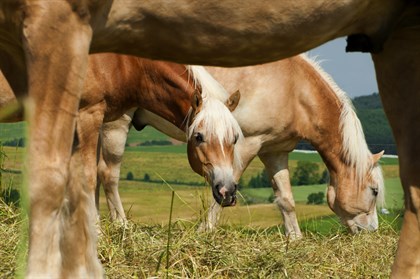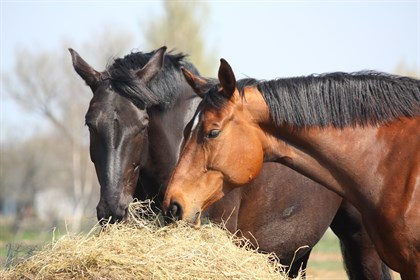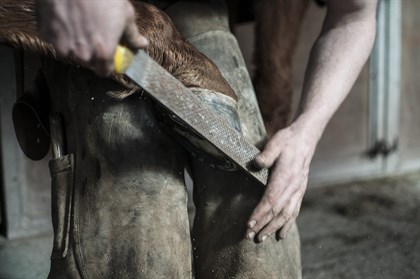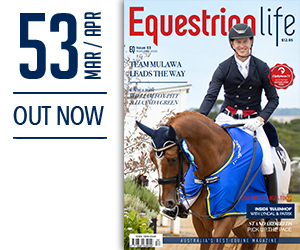|

During the current pandemic, some riders are choosing to spell their horses
© Kentucky Equine Research
By Kentucky Equine Research Staff
The worldwide coronavirus pandemic has jolted the competitive horse community, as racetracks and event management teams have canceled or postponed racing days and shows. A wide range of equestrians, from Pony Club members to Olympic-caliber riders, must reshuffle training timelines and goals to mesh with new competition calendars.
Many horse owners are faced with letting down their horses, potentially providing a break from all training until societal bans are lifted. How can you safely shift a horse from near-daily exercise to a life of leisure, even if temporary? Appropriate nutrition is a key consideration during this transition.
Moving from stall to pasture
If your horse has been kept in the barn all or most of the time while actively training and showing, make the switch to pasture gradually. Start with half an hour of grazing two or three times a day, making sure to provide plenty of hay when the horse is in the stall. Increase pasture time in half-hour increments for several days, and then add an hour or two to each grazing session until the horse is able to be out all the time.
Because of the way the horse’s digestive system works, any horse relocated abruptly from stall to full pasture is at high risk for colic or laminitis. At any time during the shift, if the hooves feel warm to the touch, or the horse shows signs of pain or reluctance to move, put the horse in the stall and contact your veterinarian immediately.
Some horses are so sensitive to the sugars in grass that they can never have unlimited access to pasture. These equines can still benefit from a few weeks or months of full or partial turnout if they are muzzled or placed in a dry lot with an adequate supply of hay.
Feeding
To stay in show condition and perform the work he has been asked to do, performance horses have probably been given top-quality hay and one or more feedings of concentrate (pellets or sweet feed) daily. Without the demands of training, he will require the same basic nutrients but will need much less energy. Ideally, you can take a week or two to taper his schedule, slowly decreasing both his work and his grain ration.
Gradually switching to a balancer pellet or a vitamin and mineral supplement will supply essential nutrients without the calories found in a concentrated feed. Kentucky Equine Research has developed several vitamin and mineral supplements, including Gold Pellet® and Nutrequin Se®. Continue to give your horse whatever dietary supplements he is accustomed to, such as hoof and joint products, but check ingredients to avoid over supplementation when feeding more than one product.
You should still provide hay whenever the horse spends time in the stall, or if natural forage is lacking. Something to munch on will alleviate boredom, keep gastric ulcers at bay, and prevent gorging on grass at the next turn-out. Free-choice access to water and salt is essential at all times.

Feeding hay to stalled horses, and those with limited quality pasture, is important for gastric health and to prevent boredom
© Kentucky Equine Research
Pasture safety
Take a quick tour of the fenceline and field to check for debris, holes, loose boards or wire, and insecure gate latches, and correct any problems before using the field.
Changing seasons may eliminate insect problems, but horses with white faces may need sun protection year-round. Sunscreen or fly masks with muzzle extensions can prevent painful sunburn.
Hoof care
Many people feel it is advantageous for horses to go barefoot if they are going to be inactive for several months. Will your horse benefit from having his shoes pulled? Consider these things as you make this decision.
- Horses that are newly barefoot will probably be somewhat tender for a week or so until the soles begin to toughen. If possible, turn out in a field with grass or dirt rather than a rocky area, and pasture the horse with amiable companions to avoid forcing him to run or kick to defend himself.
- Hoof shape will change without the support of a shoe. Normal changes include spreading of the heel, flaring in the quarters, and chipping at the toe and sides of the hoof.
- Whether the horse is shod or barefoot, basic hoof care should not change when the horse is out of work. Hooves should be inspected and picked daily, and the schedule of farrier visits should be maintained. Toes tend to grow faster than quarters and heels, so going more than about six weeks between trimmings can change the angle of the pastern, leading to unnecessary strain on the tendons and ligaments in the lower leg.
- Horses that have therapeutic shoeing for navicular syndrome, laminitis, or other hoof problems may need to remain shod. Discuss with your farrier whether to leave the idle horse shod, to remove only the rear shoes, or to pull all the shoes until the horse returns to work.
- Maintain horses on a high-quality hoof supplement like Bio-Bloom™ HF.

Ensure your horse receives adequate hoof care, regardless of whether it is kept shod or barefoot
Other management considerations
Even though he is not working, your horse still needs daily attention. A light grooming gives you a chance to find and treat injuries or skin conditions. Face masks and grazing muzzles should be removed at least once a day to check for rubbed areas. A regular schedule of deworming, vaccinations, and dental care should be followed just as though the horse were still in training.
Do you have questions about how best to nourish your horse as he transitions from an active lifestyle to a sedentary one? Ask a Kentucky Equine Research nutrition advisor. Contact the team on advice@ker.com or 1800 772 198.
READ THE LATEST NEWS ARTICLES HERE

|

